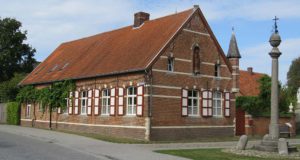Background & History
The origins of the congregation can be traced back to the early 18th century. In 1722, a meeting of ‘more or less devout women’ was founded in Gestel by pastor Ambrosius Van den Bosch.

Such small-scale religious communities are common in our region in the 17th and 18th centuries. Usually it concerns a number of pious women who want to lead a religious life in community under the guidance of a parish priest. Such communities should of course not be confused with an official congregation.
Although the women live in community, often wear uniform clothing and do apostolic work, they have not taken any vows, for example, unlike monks. The inhabitants of Gestel therefore do not address the ‘pious daughters’ as monks, but as ‘marolles’. According to pastor Van den Bosch, these pious daughters can help with ‘cleaning and decorating the church, or to teach some children to read, write.’
The story continues in Berlaar
It is interesting to note that the forerunners of the later Congregation devoted themselves to education from the very beginning. However, this is not appreciated by everyone. Koster Walter Van Rompuy is officially responsible for education in the small village and thinks that the marolles are too much on his territory. After the death of pastor Van den Bosch, the sexton manages to incite part of the village and the new pastor against this meeting of pious daughters. This eventually leads to an investigation by the secular authorities that finds that the assembly was illegally established. And so in 1738 the assembly is officially dissolved. Two of the three original marolles then decide to move to Berlaar and continue their community life there. Here they are allowed by parish priest Struyve to devote themselves to the education of young girls.
In 1830 Henricus Haes is appointed as the new parish priest of Berlaar. At that time, only one of the marolles remained, Maria Theresia Vermeylen. She and pastor Haes get along well and under their impulse the number of members grows again. They dream of eventually transforming the meeting into an official Congregation. Unfortunately, Maria Theresia Vermeylen will not live to see that official recognition as a religious community on March 14, 1845. She died on August 23, 1844, but her ‘Spiritual Testament’ became an important compass for the Sisters of the Sacred Heart of Maria van Berlaar.
The influence of World War II
After the Second World War, the need for qualified personnel within the health sector arose. The hospitals are equipped with more modern, technical equipment and offer specialized services. The government, for its part, applies stricter diploma requirements in the context of the statutory recognition standards for hospitals. This ensures training initiatives within the congregation that are primarily intended for its own members. The sisters are also asked to take on the management of government nurse training institutions. For example , from 1945 the midwife school (since 1912 associated with the provincial maternity of Hasselt) came under their care.
From 1954 the sisters ran a school for nurses and midwives, attached to the Sint-Bartholomeüsgasthuis in Merksem. This institution would also evolve into a higher institution. That same year, on March 28, 1954, the Congregation laid the foundation stone of the Holy Family Maternity in Heist-op-den-Berg. Since it was decided in 1972 that single maternity units were not allowed to continue to exist, the facility in Heist -op-den-Berg was converted into a “rest home” (wzc Heilige Familie) that same year.
The future of the ‘Berlaarse’ schools without a congregation has been prepared with great care for quite some time now. The last generation of sisters wants to pass on the torch as best they can. Major infrastructure works and numerous smaller renovations with the support of the Congregation’s economist are not unfamiliar to this process. The updating of the education project ‘Being a Heart of God on Earth’ is also an expression of grateful and hopeful handing over.
The story goes on
The congregational efforts in the education sector still appeal to the imagination. For many decades the sisters have worked hard and there was a lot of building activity. Intense prayers and warm care have constantly formed the common thread.
Despite rapidly changing times and periods of upscaling the educational mission remained the same: providing high quality education with a lot of growth opportunities for children and young people, and with special attention for the weakest among them. And this will be no different in the future.
(Translation: Filip Laeveren, Werner Beyers)
Nieuws
Welzijnsschakels steunt al 32 jaar Berlaarse gezinnen in armoede
In Berlaar zet vzw Welzijnsschakels zich al meer dan 32 jaar in voor Berlaarnaren die het moeilijk hebben. Zuster Monique Van den Broeck (70), één van de drijvende krachten achter de organisatie, vertelt aan GVA [...]
Boek en voordracht (download) Passie en twijfel
Klik hier voor de boekbespreking en de voordracht: "Passie en twijfel" door Eva Vromman
